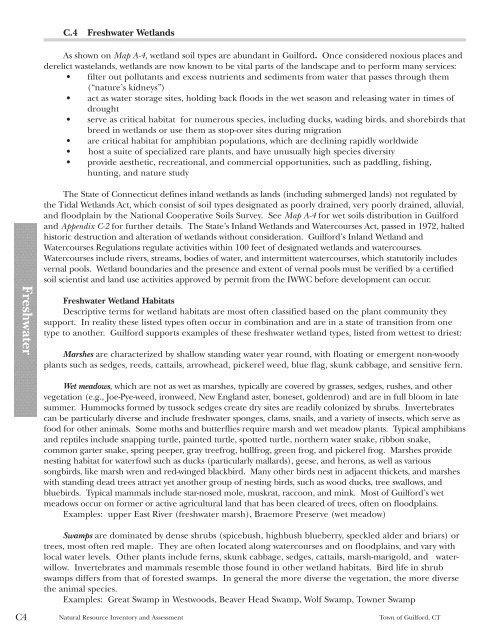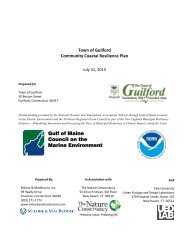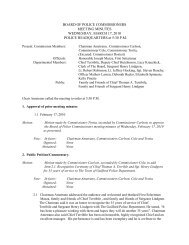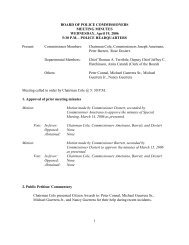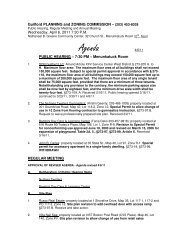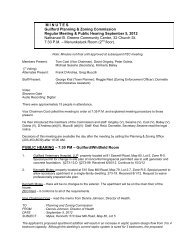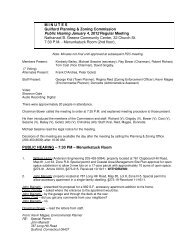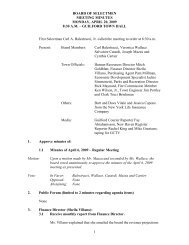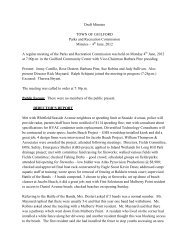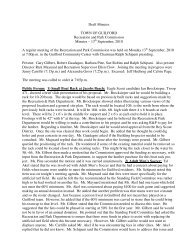Natural Resource Inventory and Assessment - Town of Guilford
Natural Resource Inventory and Assessment - Town of Guilford
Natural Resource Inventory and Assessment - Town of Guilford
Create successful ePaper yourself
Turn your PDF publications into a flip-book with our unique Google optimized e-Paper software.
Freshwater<br />
C4<br />
C.4 Freshwater Wetl<strong>and</strong>s<br />
As shown on Map A-4, wetl<strong>and</strong> soil types are abundant in <strong>Guilford</strong>. Once considered noxious places <strong>and</strong><br />
derelict wastel<strong>and</strong>s, wetl<strong>and</strong>s are now known to be vital parts <strong>of</strong> the l<strong>and</strong>scape <strong>and</strong> to perform many services:<br />
• filter out pollutants <strong>and</strong> excess nutrients <strong>and</strong> sediments from water that passes through them<br />
(“nature’s kidneys”)<br />
• act as water storage sites, holding back floods in the wet season <strong>and</strong> releasing water in times <strong>of</strong><br />
drought<br />
• serve as critical habitat for numerous species, including ducks, wading birds, <strong>and</strong> shorebirds that<br />
breed in wetl<strong>and</strong>s or use them as stop-over sites during migration<br />
• are critical habitat for amphibian populations, which are declining rapidly worldwide<br />
• host a suite <strong>of</strong> specialized rare plants, <strong>and</strong> have unusually high species diversity<br />
• provide aesthetic, recreational, <strong>and</strong> commercial opportunities, such as paddling, fishing,<br />
hunting, <strong>and</strong> nature study<br />
The State <strong>of</strong> Connecticut defines inl<strong>and</strong> wetl<strong>and</strong>s as l<strong>and</strong>s (including submerged l<strong>and</strong>s) not regulated by<br />
the Tidal Wetl<strong>and</strong>s Act, which consist <strong>of</strong> soil types designated as poorly drained, very poorly drained, alluvial,<br />
<strong>and</strong> floodplain by the National Cooperative Soils Survey. See Map A-4 for wet soils distribution in <strong>Guilford</strong><br />
<strong>and</strong> Appendix C-2 for further details. The State’s Inl<strong>and</strong> Wetl<strong>and</strong>s <strong>and</strong> Watercourses Act, passed in 1972, halted<br />
historic destruction <strong>and</strong> alteration <strong>of</strong> wetl<strong>and</strong>s without consideration. <strong>Guilford</strong>’s Inl<strong>and</strong> Wetl<strong>and</strong> <strong>and</strong><br />
Watercourses Regulations regulate activities within 100 feet <strong>of</strong> designated wetl<strong>and</strong>s <strong>and</strong> watercourses.<br />
Watercourses include rivers, streams, bodies <strong>of</strong> water, <strong>and</strong> intermittent watercourses, which statutorily includes<br />
vernal pools. Wetl<strong>and</strong> boundaries <strong>and</strong> the presence <strong>and</strong> extent <strong>of</strong> vernal pools must be verified by a certified<br />
soil scientist <strong>and</strong> l<strong>and</strong> use activities approved by permit from the IWWC before development can occur.<br />
Freshwater Wetl<strong>and</strong> Habitats<br />
Descriptive terms for wetl<strong>and</strong> habitats are most <strong>of</strong>ten classified based on the plant community they<br />
support. In reality these listed types <strong>of</strong>ten occur in combination <strong>and</strong> are in a state <strong>of</strong> transition from one<br />
type to another. <strong>Guilford</strong> supports examples <strong>of</strong> these freshwater wetl<strong>and</strong> types, listed from wettest to driest:<br />
Marshes are characterized by shallow st<strong>and</strong>ing water year round, with floating or emergent non-woody<br />
plants such as sedges, reeds, cattails, arrowhead, pickerel weed, blue flag, skunk cabbage, <strong>and</strong> sensitive fern.<br />
Wet meadows, which are not as wet as marshes, typically are covered by grasses, sedges, rushes, <strong>and</strong> other<br />
vegetation (e.g., Joe-Pye-weed, ironweed, New Engl<strong>and</strong> aster, boneset, goldenrod) <strong>and</strong> are in full bloom in late<br />
summer. Hummocks formed by tussock sedges create dry sites are readily colonized by shrubs. Invertebrates<br />
can be particularly diverse <strong>and</strong> include freshwater sponges, clams, snails, <strong>and</strong> a variety <strong>of</strong> insects, which serve as<br />
food for other animals. Some moths <strong>and</strong> butterflies require marsh <strong>and</strong> wet meadow plants. Typical amphibians<br />
<strong>and</strong> reptiles include snapping turtle, painted turtle, spotted turtle, northern water snake, ribbon snake,<br />
common garter snake, spring peeper, gray treefrog, bullfrog, green frog, <strong>and</strong> pickerel frog. Marshes provide<br />
nesting habitat for waterfowl such as ducks (particularly mallards), geese, <strong>and</strong> herons, as well as various<br />
songbirds, like marsh wren <strong>and</strong> red-winged blackbird. Many other birds nest in adjacent thickets, <strong>and</strong> marshes<br />
with st<strong>and</strong>ing dead trees attract yet another group <strong>of</strong> nesting birds, such as wood ducks, tree swallows, <strong>and</strong><br />
bluebirds. Typical mammals include star-nosed mole, muskrat, raccoon, <strong>and</strong> mink. Most <strong>of</strong> <strong>Guilford</strong>’s wet<br />
meadows occur on former or active agricultural l<strong>and</strong> that has been cleared <strong>of</strong> trees, <strong>of</strong>ten on floodplains.<br />
Examples: upper East River (freshwater marsh), Braemore Preserve (wet meadow)<br />
Swamps are dominated by dense shrubs (spicebush, highbush blueberry, speckled alder <strong>and</strong> briars) or<br />
trees, most <strong>of</strong>ten red maple. They are <strong>of</strong>ten located along watercourses <strong>and</strong> on floodplains, <strong>and</strong> vary with<br />
local water levels. Other plants include ferns, skunk cabbage, sedges, cattails, marsh-marigold, <strong>and</strong> waterwillow.<br />
Invertebrates <strong>and</strong> mammals resemble those found in other wetl<strong>and</strong> habitats. Bird life in shrub<br />
swamps differs from that <strong>of</strong> forested swamps. In general the more diverse the vegetation, the more diverse<br />
the animal species.<br />
Examples: Great Swamp in Westwoods, Beaver Head Swamp, Wolf Swamp, <strong>Town</strong>er Swamp<br />
<strong>Natural</strong> <strong>Resource</strong> <strong>Inventory</strong> <strong>and</strong> <strong>Assessment</strong> <strong>Town</strong> <strong>of</strong> <strong>Guilford</strong>, CT


